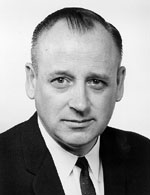George B. Hartzog Jr.
George B. Hartzog Jr. | |
|---|---|
 | |
| 7th Director of the National Park Service | |
| In office January 9, 1964 – December 31, 1972 | |
| President | Lyndon B. Johnson Richard Nixon |
| Preceded by | Conrad L. Wirth |
| Succeeded by | Ronald H. Walker |
| Personal details | |
| Born | March 17, 1920 Smoaks, South Carolina[1] |
| Died | June 27, 2008 (aged 88) Washington, D.C. |
| Spouse |
Helen Hartzog (m. 1947) |
| Occupation | Lawyer, conservationist |
George Benjamin Hartzog Jr. (March 17, 1920 – June 27, 2008) was an American attorney and Director of the National Park Service. Admitted to the bar in South Carolina in 1942, he became an attorney for the General Land Office (now the Bureau of Land Management) in the Department of the Interior in 1945, and six months later transferred to the National Park Service.
He moved to field assignments at
National Historic Preservation Act of 1966, and the Bible amendment to the Alaska Native Claims Settlement Act that led to establishment of the Alaska parks. He ordered the Yosemite Firefall tradition discontinued in 1968. During his nine-year tenure, he enlarged the service's role in urban recreation,[2]
historic preservation, interpretation, and environmental education.
In 1969, NPS faced budget cuts. Harzog pioneered what became known as the
Washington Monument Syndrome
political tactic and closed all national parks two days a week. As public outcry grew, Congress restored the funding.
Hartzog was dismissed by President Nixon in December 1972. Afterwards, he practiced law in Washington, D.C.[3]
George B. Hartzog died on June 27, 2008.[4]
References
- ^ Hartzog, Jr., George B. Battling for the National Parks. New York: Mt. Kisco, 1988.
- ^ Hohmann, Heidi (June 21, 2016). "Solving the "Recreation Problem": The Development of the National Recreation Area". National Park Service. Archived from the original on January 2, 2021. Retrieved 2021-01-18.
- ISSN 0362-4331. Retrieved 2021-10-13.
- ^ Schudel, Matt. (July 6, 2008.) "Obituaries: George B. Hartzog Jr., 88; Expanded Nation's Park System. The Washington Post. Retrieved on June 14, 2010.
Further reading
- [1]
- McPhee, John/Pieces Of The Frame/Ranger
External links
- George B. Hartzog Jr. Papers at Clemson University Special Collections Library
